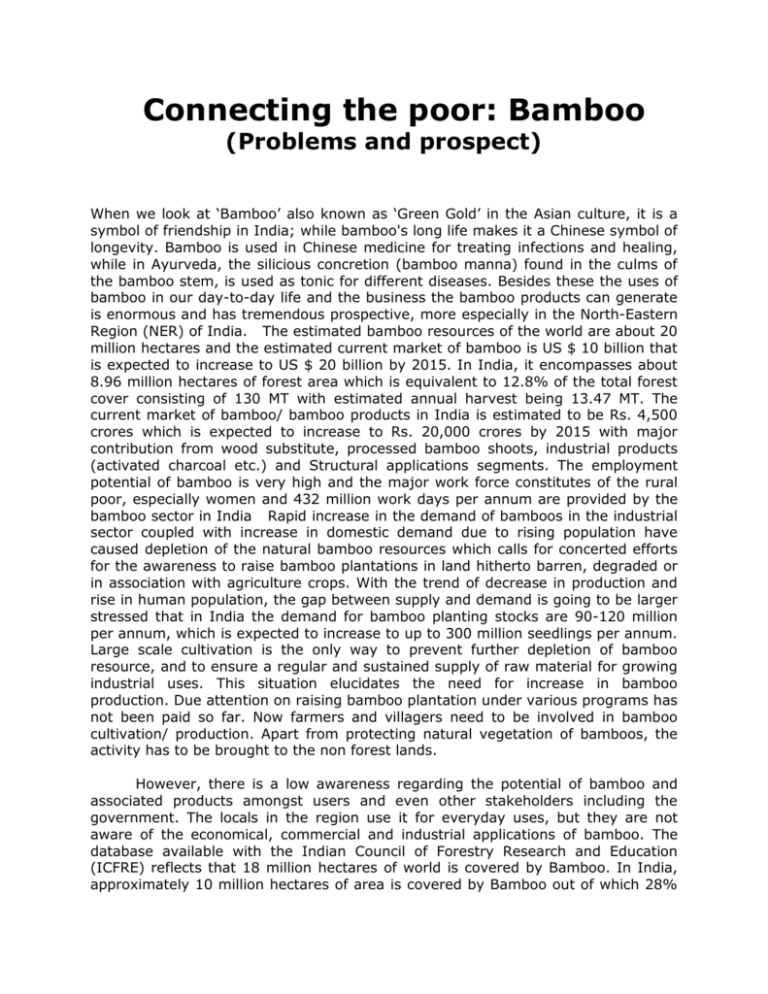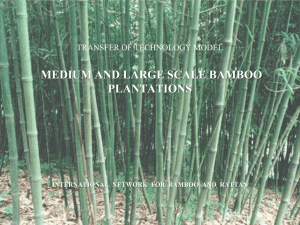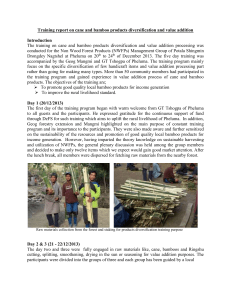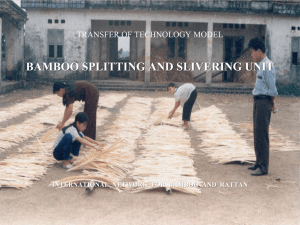Connecting the poor: Bamboo (Problems and prospect)
advertisement

Connecting the poor: Bamboo (Problems and prospect) When we look at ‘Bamboo’ also known as ‘Green Gold’ in the Asian culture, it is a symbol of friendship in India; while bamboo's long life makes it a Chinese symbol of longevity. Bamboo is used in Chinese medicine for treating infections and healing, while in Ayurveda, the silicious concretion (bamboo manna) found in the culms of the bamboo stem, is used as tonic for different diseases. Besides these the uses of bamboo in our day-to-day life and the business the bamboo products can generate is enormous and has tremendous prospective, more especially in the North-Eastern Region (NER) of India. The estimated bamboo resources of the world are about 20 million hectares and the estimated current market of bamboo is US $ 10 billion that is expected to increase to US $ 20 billion by 2015. In India, it encompasses about 8.96 million hectares of forest area which is equivalent to 12.8% of the total forest cover consisting of 130 MT with estimated annual harvest being 13.47 MT. The current market of bamboo/ bamboo products in India is estimated to be Rs. 4,500 crores which is expected to increase to Rs. 20,000 crores by 2015 with major contribution from wood substitute, processed bamboo shoots, industrial products (activated charcoal etc.) and Structural applications segments. The employment potential of bamboo is very high and the major work force constitutes of the rural poor, especially women and 432 million work days per annum are provided by the bamboo sector in India Rapid increase in the demand of bamboos in the industrial sector coupled with increase in domestic demand due to rising population have caused depletion of the natural bamboo resources which calls for concerted efforts for the awareness to raise bamboo plantations in land hitherto barren, degraded or in association with agriculture crops. With the trend of decrease in production and rise in human population, the gap between supply and demand is going to be larger stressed that in India the demand for bamboo planting stocks are 90-120 million per annum, which is expected to increase to up to 300 million seedlings per annum. Large scale cultivation is the only way to prevent further depletion of bamboo resource, and to ensure a regular and sustained supply of raw material for growing industrial uses. This situation elucidates the need for increase in bamboo production. Due attention on raising bamboo plantation under various programs has not been paid so far. Now farmers and villagers need to be involved in bamboo cultivation/ production. Apart from protecting natural vegetation of bamboos, the activity has to be brought to the non forest lands. However, there is a low awareness regarding the potential of bamboo and associated products amongst users and even other stakeholders including the government. The locals in the region use it for everyday uses, but they are not aware of the economical, commercial and industrial applications of bamboo. The database available with the Indian Council of Forestry Research and Education (ICFRE) reflects that 18 million hectares of world is covered by Bamboo. In India, approximately 10 million hectares of area is covered by Bamboo out of which 28% is in the NER. There are more than 125 species belonging to 23 genera of bamboos found in India. Out of this, only 30 species are commercially important. They grow naturally up to 3500 m above mean sea level. 66% of India’s bamboo resources exist in NER and hence, the potentialities. The requirement of “bamboo wood” for multiple uses by the industries and the common man will definitely increase in far greater dimensions. In India, the total demand of various bamboo consuming sectors is estimated at 26.9 million tonnes. The estimated supply is only 13.47 million tonnes i.e. only half of the total demand. The pulp and paper industry, construction, cottage industry and handloom, food, fuel, fodder and medicine annually consume about 13.4 million tonnes of bamboo amounting to Rs. 2042 crores. Demand of bamboo for industrial use is met from state owned forests, while for non industrial purpose it comes from private as well as state owned resources. Keeping abreast of versatility of bamboo uses and its potential to build up the rural economy, Government of India launched massive programme viz. National Bamboo Mission for over all development of bamboo sector in the country and also to improve the Indian representation in global bamboo market. Bamboo has also been recommended for plantations for a greener, pollution free environment along with economic prosperity. Based on India’s rich culture, bamboo utilization has triggered several programmes in the country for economic and industrial development through the use of bamboo. Large targets for plantations across the country have been fixed. The National Bamboo Mission (India) envisages covering over 1.76 lakh hectare area through bamboo. This will need over 70 million field plantable saplings to raise bamboo plantations. The emphasis of the National Bamboo Mission is on an area based regionally differentiated strategy, for both forest and non- forest areas. A number of activities are proposed to be taken up for increasing production of bamboo through area specific species/varieties with high yield, plantation development and dissemination of technologies through a seamless blend of traditional wisdom and scientific knowledge, along with the convergence and synergy amongst stakeholders. Besides ensuring proper post-harvest storage and treatment facilities, marketing and export National Bamboo Mission is committed to assure appropriate returns to growers/producers. Also, bamboo development is viewed as an instrument of poverty alleviation and employment generation for skilled and unskilled persons, especially unemployed youth particularly in the rural sector through ecorehabilitation purposes To support cause of the NBM for the development in the bamboo sector the situational as well as practical and legal constraints need to be removed. At present bamboo is classified as a ‘tree’ under the Indian Forest Act, 1927, and therefore, the various restrictions applicable to trees under the Act and its Rules apply to bamboo. The Supreme Court in T.N.Godavarman Thirumulkpad vs. Union of India (1977) ordered a complete ban on the felling of any trees. Further, the SC ordered a complete ban on the movement of cut trees and timber from any of the seven North-Eastern states to any other state of the country either by rail, road or waterways. The cultivation, harvest and transport of bamboo are therefore constrained by the said judgment read with the Indian Forest Act. Nagaland state, however, has lifted restrictions on bamboo, but since the neighboring states have not lifted restrictions it is difficult to transport the produce beyond the state of Nagaland. While there is no restriction on the cultivation of bamboo on private lands, but transporting bamboo across the state boundaries or even within a state becomes problematic as forest and other officials at every check-point have to be satisfied that the bamboo being transported has been from private lands and not from forest lands. Therefore, the primary hindrance in respect of commercialization of bamboo is transport permits. China successfully has been the main driving force in the global bamboo industry’s development over the last 15 years, with a global share of almost 80%. The total world market for bamboo is worth USD 7 billion/year with handicrafts taking up just over 40%. Oxfam Hong Kong predicts that the global market will continue to grow to an estimated value of USD 15-20 Billion/year by 2017. India has opened its boundaries to the market economy and is promoting itself as being on the crossroads of trade between China and Southeast Asia. Although policy reforms are continuing, doing business in India is still a challenge for the private sector. Many have recognized the great potential of bamboo as an industry, be it for handicrafts, shoots or industrial processing. Yet few countries have so far been able to develop their bamboo industries beyond their traditional handicraft markets to exploit the huge potential for rural economic growth and the resulting poverty reduction. While bamboo handicrafts exist around the world, the industrial bamboo sub-sector is too often notable only by its absence. Considerable challenges exist for those aspiring to replicate the success of regions such as Anji, Li’nan and Fujian in China. Such leading regions and their associated industries have set the benchmark in terms of cost and efficiency of production, exploiting competitive advantages from the development of dense industrial bamboo clusters. At the same time they have seemingly lowered technical barriers to entry by commercializing much of the technology and opening the markets to bamboo-based products. So why, with available technologies, developing markets and local bamboo resources, has it proved so difficult for others to replicate the success of China or Vietnam? Why have industrial bamboos clusters not emerged more widely and achieved the same large impacts on rural development and poverty reduction? The challenge for those outside China (countries and regions as well as private enterprises) has been how to make the transition from traditional, often small scale, processing industries to the efficiencies and scale needed to compete in the world market against China. China’s leading bamboo regions have achieved remarkable efficiencies in utilizing every part of the bamboo that leaves the forest – with raw material conversion rates often exceeding 95%, including branches and leaves as well as the main culms themselves. With every part of the bamboo being used somewhere in the industry, individual businesses are able to buy only the exact part of the bamboo they require for their particular product and achieve low unit costs of production despite some of the world’s highest farm-gate prices for raw bamboo. The efficiency in material utilization has been made possible by the development of relatively complex and geographically concentrated supply chains. The strong competition for raw material among businesses means that every part of the bamboo is used for the products of greatest added value and businesses constantly strive to find ways to increase their efficiency and value addition to the bamboo. The Chinese industry has also been relentless in its innovations in processing and machinery. These have allowed it to achieve increasing labour productivity to off-set the rising cost of workers. For those outside of China, the efficiencies of the Chinese industry have made it very difficult to compete with in export markets. Emerging industries elsewhere often struggle with raw material utilization rates for added value products of perhaps 15%-25%. The dramatically higher efficiencies in China mean that the sales prices of Chinese bamboo products are often lower than the cost of production of similar products elsewhere where, despite big differences in the cost of raw materials and labour. The financial viability of bamboo related commercial projects is another problem we need to look into. The financial institutions are wary of the facts regarding operational difficulties, logistics and supply chain problem, track record of stakeholders, lack of developed market for bamboo products and lack of work ethics. In such a situation banks want increased participation of all stakeholders and subsidy by the government. In such a situation development of suitable, small but profitable industrial investment opportunities in the bamboo and cane sector would be a necessary first step of the development of the sector, and thereby employment to the disgruntled youth. There is no National Policy on Bamboo .A National Policy or Policy on Bamboo for the NER will definitely boost the value added products made from bamboo. In NE State the state of Nagaland Government’s initiative to create the Nagaland Bamboo Development Agency (NBDA) has made exemplary model in the country for institutionalizing bamboo for community. Also made its highest effort to make awareness of bamboo in the country by hosting the First “World Bamboo Day” Celebration at Kisama, Nagaland on 18th September 2010 which was graced by the Vice President of India H.E. Shri Hamid Ansari which was attended by delegates from all India and more than 15 countries. To commoditize bamboo there is a great need to carry out institutional reform and restructuring. The examples of “Tea Board”, “Coffee Board”, “Coconut Development Board”, “Spice Board”, “Jute Development Board”, “Silk Board”, “Rubber Board”, “Coir Board” under various ministries of Government of India are examples of commoditization. These bodies acts as “one stop shop” and looks after all the requirements from development, promotional, plantation to processing and marketing of the product including R&D activities and market promotion etc. The bamboo sub-sector in North East is undeveloped due to a lacking enabling environment to stimulate the private sector to invest in the states. Capacity of government staff to tackle reforms and necessary insights to promote and develop marketable products is limited. Consequently private sector and poor communities have few incentives to sustainable manage and gain from trading bamboo resources. Key intervention areas to support the development of the bamboo value chain are the enabling business climate, handicraft sector and piloting business models aiming at providing benefits for both the private sector and communities. Lessons from China, Vietnam and other South Asian Countries are needed to be learnt for India. India’ Aggarbatti Industry (Incense Sticks) which is pegged at Rs.4000 crore market imports bulk of the required bamboo sticks from China and Vietnam whereas abundant bamboo resources in NE States are burnt by Jhumming or pulped for paper by the two giant Paper Mills in the region leaving less scope for the farmers for value addition and benefits. Bamboo is useful for ecological and environmental purposes as well. It is one of the best species for carbon sequestration; it conserves soil and water besides many other protective purposes Since, market for environment-friendly “green” products is growing, India must try to secure her due share in world bamboo market which is expected to grow from USD 10 billion to over USD 20 billion by 2015, if we could expand the bamboo economy steadily to Rs. 26,000 Crore by 2015 from Rs. 2000 Crore, as envisioned by the Building Materials and Technology Promotion Council (BMPTC), Govt. of India. To achieve this target the social and commercial aspects of bamboo and bamboo products need to be disseminated at the grass root level. Simultaneously, a programme of awareness building is needed to influence the government (commerce, industry and various ministries), bankers, potential traders and investors on the potential of bamboo – economic, social and environmental. However, this awareness has to be built regarding benefits they can relate to – the value proposition, people and environmental friendliness of bamboo and connecting the poor. (The above are the views of the author) By: Mr.Kamesh Salam Founder and Executive Director, South Asia Bamboo Foundation (SABF). Former President World Bamboo Organization (WBO). E mail- southasiabamboo@gmail.com









